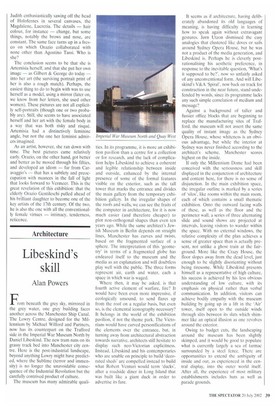Lib eskind's skill
Alan Powers
From beneath the grey sky, mirrored in the grey water, one grey building faces another across the Manchester Ship Canal. The Lowry Centre, designed for the Millennium by Michael Wilford and Partners, now has its counterpart on the Trafford side in the Imperial War Museum North by Daniel Libeskind. The new tram runs on its grassy track bed into Manchester city centre. Here is the post-industrial landscape, beyond anything Lowry might have predicted, where the Sublime (terror and immensity) is no longer the unavoidable consequence of the Industrial Revolution but the carefully contrived product of culture.
The museum has many admirable quali
ties. In its programme, it is more an exhibition pavilion than a centre for a collection or for research, and the lack of complication helps Libeskind to achieve a coherent and legible relationship between inside and outside, enhanced by the internal presence of some of the formal features visible on the exterior, such as the tall tower that marks the entrance and divides the main gallery from the temporary exhibition gallery. In the irregular shapes of the roofs and walls, we can see the fruits of the computer in architecture, for it is now much easier (and therefore cheaper) to plot non-orthogonal shapes than even ten years ago. While the same architect's Jewish Museum in Berlin depends on straight lines, Manchester has curves and twists, based on the fragmented surface of a sphere. The interpretation of this 'geometry' in terms of a fragmented globe has endeared itself to the museum and the media as an explanation and will doubtless play well with the public. The three forms represent air, earth and water, each a space in which war is waged.
Where then, it may be asked, is that fourth active element of warfare, fire? It would have been even more impressive, if ecologically unsound, to send flares up from the roof on a regular basis, but even so, is the elemental iconography necessary? It belongs in the world of the exhibition pavilion, if not the theme park. The Victorians would have carved personifications of the elements over the entrance, but, in turning away from architectural abstraction towards narrative, architects still hesitate to display such neo-Victorian explicitness. Instead, Libeskind and his contemporaries who are unable on principle to build 'decorated sheds' are compelled instead to build what Robert Venturi would term 'ducks', after a roadside diner in Long Island that was built like a giant duck in order to advertise its fare. It seems as if architecture, having deliberately abandoned its old languages of meaning, is having difficulty in learning how to speak again without extravagant gestures. Jorn Utzon dismissed the easy analogies that clustered like doves or sails around Sydney Opera House, but he was not a product of the media generation, and Libeskind is. Perhaps he is cleverly postrationalising his aesthetic preference, in response to the inevitable question, 'What's it supposed to be?', now so unfairly asked of any unconventional form. And will Libeskind's V&A 'Spiral', now back on track for construction in the near future, stand undefended by words, since its programme lacks any such simple correlation of medium and message?
Against a background of taller and fussier office blocks that are beginning to replace the manufacturing sites of Trafford, the museum will not assert the same quality of instant image as the Sydney Opera House, whose whiteness is an obvious advantage, but while the interior at Sydney was never finished according to the architect's scheme, Manchester scores highest on the inside.
If only the Millennium Dome had been conceived with the seriousness and skill displayed in the conjunction of architecture and content here, for there is no sense of disjunction. In the main exhibition space, the irregular outline is marked by a series of 'silos', like rooms within the main room, each of which contains a small thematic exhibition. Onto the outward facing walls of these, as well as the floor and the perimeter wall, a series of three alternating slide and sound shows are projected at intervals, leaving visitors to wander within the space. With no external windows, the relative complexity of the plan achieves a sense of greater space than is actually present, not unlike a ghost train at the fairground. More like the Crazy House, the floor slopes away from the dead level, just enough to be slightly disorienting without being tiresome. While Libeskind presents himself as a representative of high culture, his success is achieved by his less obvious understanding of low culture, with its emphasis on physical rather than verbal communication. In addition, visitors can achieve bodily empathy with the museum building by going up in a lift in the 'Air' tower, itself open to the outside winds through slits between its slats which shimmer like an optical illusion as one revolves around the exterior.
Owing to budget cuts, the landscaping around the museum has been slightly skimped, and it would be good to populate what is currently largely a sea of tarmac surrounded by a steel fence. There are opportunities to extend the ambiguity of inside and out, as experienced in the central display, into the outer world itself. After all, the experience of most military establishments includes huts as well as parade grounds.


























































 Previous page
Previous page